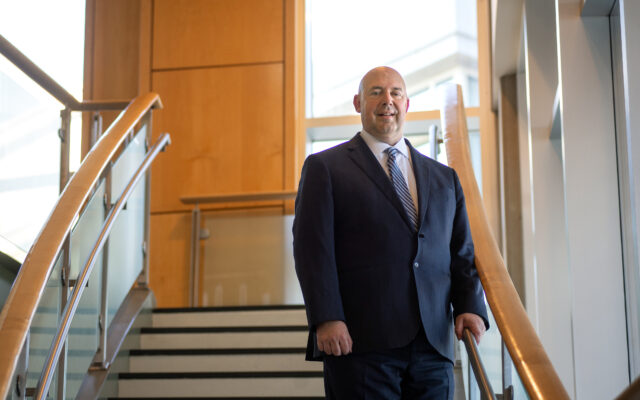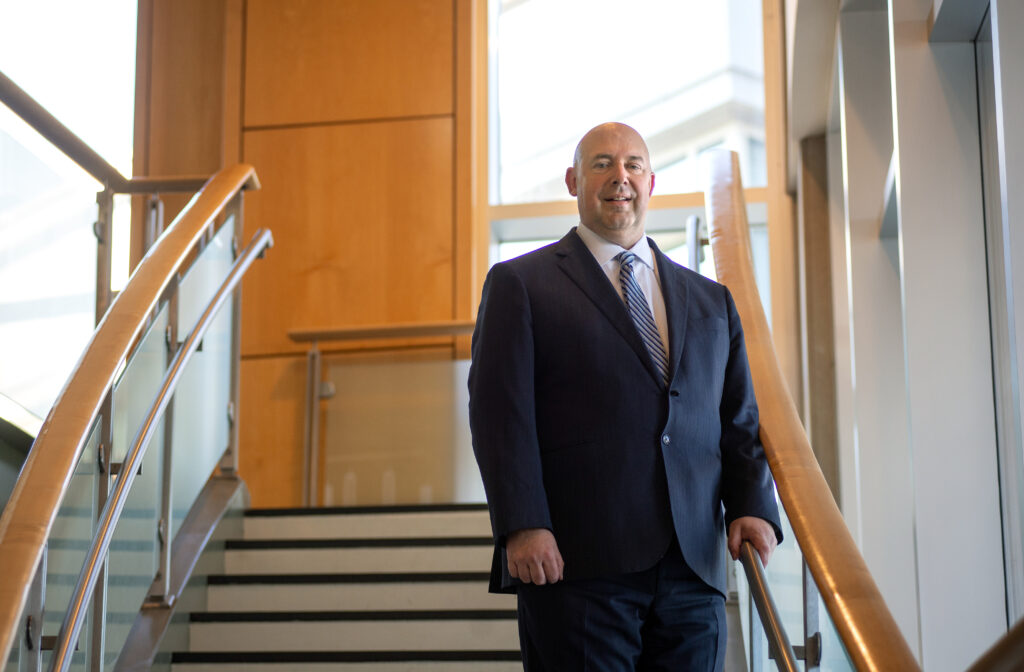
Northern Light Health’s finance chief discusses its $100M deficit
By Marie Weidmayer, Bangor Daily News Staff
After a stretch of weeks that have shed light on the financial turmoil at Northern Light Health and culminated in staffing turnover in its highest ranks, the Bangor Daily News sat down with the system’s chief financial officer, James Rohrbaugh, Oct. 23.
The challenges are clear for Rohrbaugh, who just started his job in July after working in health care for about 30 years. The organization is on track to lose more $100 million this year, after doing so in 2022 as well, and it has around $620 million in debt.
Now, one credit rating agency has downgraded its assessment of Northern Light, and another warned this week that there is a 50 percent chance it could do so in the next few months.

CFO — James Rohrbaugh, chief financial officer of the Northern Light Health system, is photographed in the Cianchette Building in Brewer.
The challenges are noteworthy because Northern Light is one of the state’s biggest health care systems, with hospitals and clinics stretching from southern Maine to Aroostook County. It’s also one of the state’s biggest private employers.
While Northern Light officials now say they’re now taking steps to address the bleak financial picture, Rohrbaugh declined to provide an estimated goal of what an improved deficit would look like for the organization in 2025.
“I think we’re trying to figure out all the things we can do right now,” he said. “So I’m not going to throw a number out there at the moment. We would expect some significant level of improvement year over year.”
In recent years, Northern Light has been taking steps to recover from a variety of operating and financial challenges that first arose during the COVID pandemic. It has closed some clinics, changed programs, sold off its laboratory services and outsourced non-medical jobs to outside companies.
But the leadership shakeup that hit the system last week stood out for removing some of its better-paid administrators, which could help to preserve frontline medical jobs. Between Wednesday and Friday, three high-ranking executives lost their jobs as part of what Northern Light says are “difficult but necessary decisions” meant to shrink its overhead.
It’s too early to say what the economic impact will be from the departure of those executives, Rohrbaugh said. Two of the three jobs will not be refilled, but the system’s flagship hospital, Northern Light Eastern Maine Medical Center in Bangor, will start the search for a new president in the spring.
Based on publicly available salary data in Northern Light’s tax filings, the annual savings from ending those two positions could total more than $600,000.
Tricia Costigan stepped down from her role as president of Northern Light Inland Hospital in Waterville and Northern Light Continuing Care, Lakewood. She made $317,547 from Northern Light and its affiliates in the 2022 fiscal year, according to tax filings.
Mike Smith, whose position as president of the Northern Light Health Foundation was eliminated last week, reportedly made $327,042 in the 2022 fiscal year.
Meanwhile, Greg La Francois, the now-former president of EMMC, earned a total of $539,847 from Northern Light and its affiliates in the 2022 fiscal year, according to filings. He took his post at EMMC in 2023, after previously serving as president of Northern Light A.R. Gould Hospital in Presque Isle.
If Northern Light can’t turn around its finances, it’s not clear if its leaders would ever consider selling the entire organization to a new parent company. But for now, that does not appear likely.
When asked if Northern Light is discussing such a sale, Rohrbaugh said, “I think, first of all, I would say we’re very committed to being here in the form that we’re in. I think there’s not an appetite for trying to find somebody else to do this.”
Northern Light is dealing with issues that affect hospitals nationwide, including growing costs associated with labor and staffing shortages. In recent years, the health system has had to pay around $115 million annually in unexpected labor costs, mostly due to contracts for more expensive traveling providers. Maine has around 2,250 fewer registered nurses than needed to staff hospitals, and there is also a physician shortage, according to Rohrbaugh.
Another nationwide issue is the rate of inflation in the wake of the pandemic. Prices have risen between 17 and 20 percent, while government reimbursement for patients who use Medicare or MaineCare has increased just 7.5 percent, Rohrbaugh said.
Around 66 percent of patients at Northern Light use Medicare or MaineCare, which is the state’s version of Medicaid, he said. He pointed to a $300 million shortfall between what it costs to care for patients and what the system has been paid.
“I think sometimes it’s hard for people to understand how difficult the economic challenges are around that,” Rohrbaugh said. “We’ve [got] to continue to educate people to help make sure that they understand what are the challenges we face.”
Another challenge facing Northern Light is the small, rural population that it serves. Health care has fixed costs and a higher volume of patients can help, but there are only so many residents in the diverse communities stretching from Portland to Presque Isle where Northern Light has hospitals, Rohrbaugh said.
To help address those challenges, the system has been embracing remote telehealth services and trying to eliminate redundancy in its staffing, he said.
“I’m very focused, in the short term, making sure that we have some financial improvement, of course,” he said. “Do we have a model to make sure that we can continue to be successful for the next 100 years? That becomes the real important part of this.”